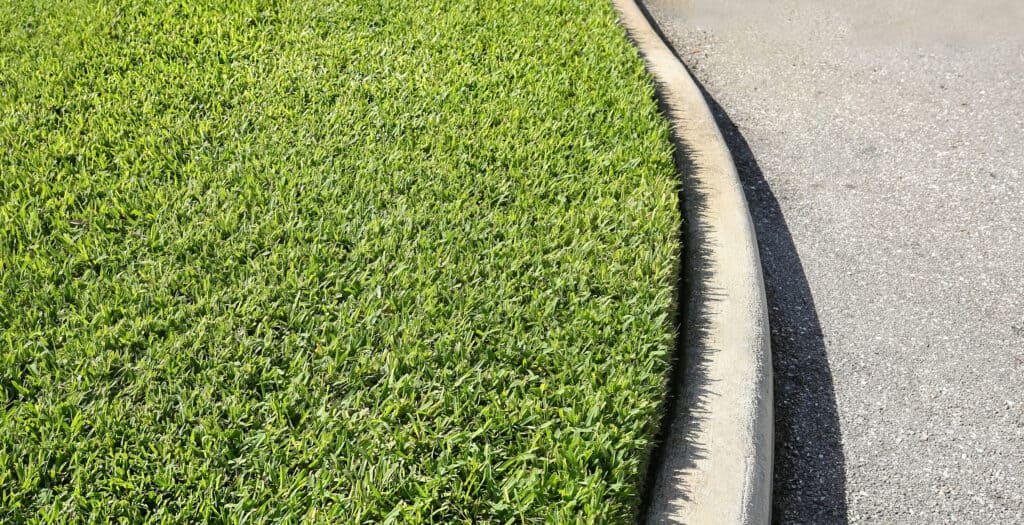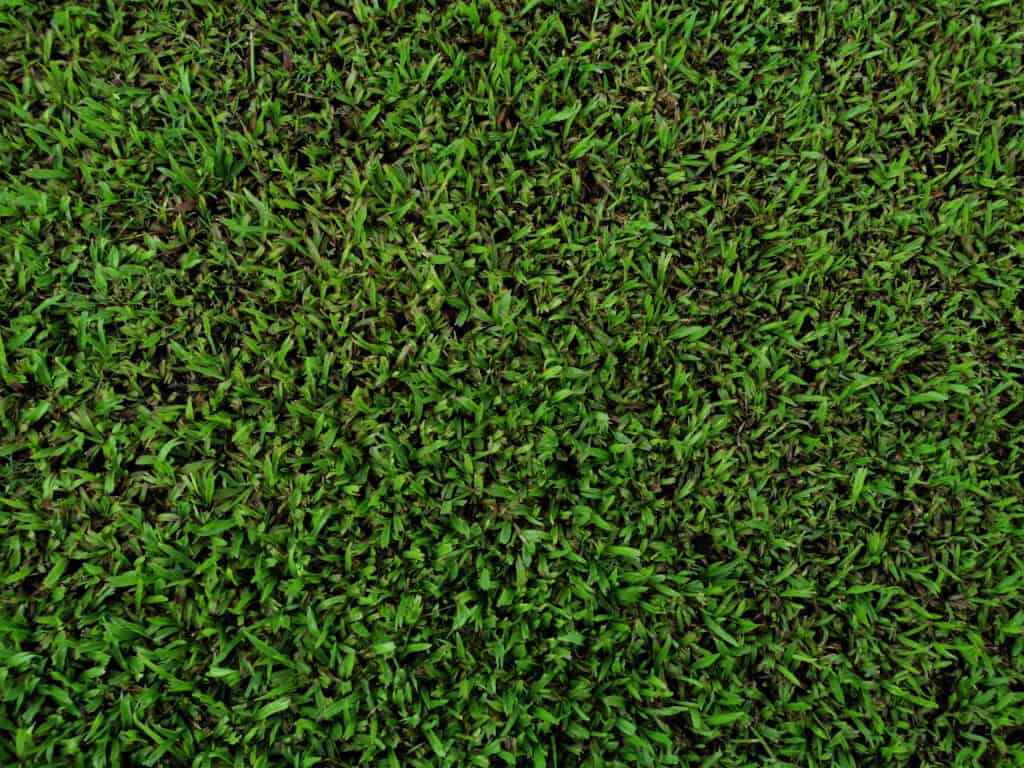You’re likely familiar with both carpetgrass and St. Augustine grass, since they’re both very popular in the U.S. and the most common varieties of grass grown in the southern states. Because these both grow in the south and are similar in many ways, most people don’t know how to tell the two apart.
Carpetgrass and St. Augustine actually have very different growing habits and maintenance requirements, so it’s important to know which grass you’re growing! Even more so if you’re trying to make a decision about which grass to grow for your own yard.
Keep reading to learn the differences between these two and find out which best suits your space!
Carpet vs. St. Augustine At A Glance
| Carpetgrass | St. Augustine | |
|---|---|---|
| Native to | Southeastern U.S. | Southeastern U.S. and Central America |
| Grows From Seed? | Yes | No |
| Appearance | Yellow-green, thin blades | Bluish-green, thick blades |
| Growth Habit | Slow and spotty, but resilient adaptable to many soils | Vigorous grower, but requires more specific growing conditions |
| Maintenace Needed | Very little | Consistent |
Similarities Between Carpetgrass and St. Augustine Grass
Despite being very different varieties, these two kinds of grass have several traits in common.
First off, they’re both native to the southeast of the U.S. and grow very well in lawns in the Gulf states. As native species, Carpet and St. Augustine both have high salt tolerances, which makes them ideal for the coastal states.
Although, both grasses can also be grown further west and have naturalized all throughout the southern U.S., except for the extremely dry and arid parts of New Mexico and Arizona.
Neither Carpet nor St. Augustine are cold hardy, meaning they don’t have much of a cold tolerance and can’t be grown north of the coastal states.
Lastly, they both require as much work to get started. You’ll see that St. Augustine requires more maintenance over time, however they need similar amounts of care right after planting.
About Carpetgrass
Carpetgrass is technically Axonopus fissifolius, or ‘Common Carpetgrass,’ although it’s common that other grasses are referred to as carpetgrass, or that this variety is called ‘Centipede Grass,’ so keep an eye out for the botanical name to be sure which variety you have.
Because carpetgrass is native to the south, it can be commonly found in landscaping or wild areas, although it’s not a very popular choice for lawns. This is because it grows pretty erratically, so the lawn doesn’t have a uniform look.
There are two main types of carpetgrass, which are broadleaf carpetgrass (Axonopus compressus) and narrowleaf carpetgrass (A. affinis). If carpetgrass is grown for lawns, it’s almost always narrowleaf carpetgrass.
Carpetgrass is a great pick, however, as turf grass or for filling dead patches, because this grass can grow in almost any conditions and grows very easily from seeds.
About St. Augustine Grass
St. Augustine is Stenotaphrum secundatum, although it’s sometimes also called carpetgrass – you can see where the confusion comes from!
St. Augustine is also native to the southern coastal states and in some areas is even considered an invasive species because it grows so intensely. This grass is slightly more cold-tolerant than carpetgrass is and will go dormant — instead of just dying — once temperatures drop below 55 degrees F.
St. Augustine doesn’t grow well from seeds, so it’s actually fairly hard to find these seeds, but this grass will grow from sod, which is the most common way to plant St. Augustine. It’s also more particular than carpetgrass about the soil and location in which it grows. Keep reading to learn more about the differences between these grasses.
Appearance
St. Augustine grass and carpetgrass have very distinct looks, especially when comparing how they look when they’re completely healthy.
The color of St. Augustine has more of a blue tint and is described as a bluish-green. St. Augustine grass has thick blades that create a dense lawn.
Carpetgrass is dark green when it’s at full health, but is most often more pale green or even yellow-green. Carpetgrass has a spotty look because it grows unevenly, which leaves some areas looking more sparse.

A benefit of St. Augustine grass is that it grows quickly, albeit aggressively.
©iStock.com/JillianCain

Carpetgrass is known for it’s growth resilience — it can thrive where most grasses won’t.
©Leestudio/Shutterstock.com
Growth Patterns
Carpetgrass and St. Augustine grass each have very distinct growing habits, which is a big determining factor depending on where and why you want to grow these grasses.
St. Augustine grass is more picky about where it grows. For example, it doesn’t tolerate shade as well and won’t grow as fast in soil with a pH above 7. St. Augustine can grow with partial shade in very hot climates, but, since it’s a warm-season grass, it really doesn’t need shade.
St. Augustine is also fairly drought tolerant, although it definitely won’t be at its best during dry spells. This grass flourishes with consistent watering but it will keep its strong green color even in hot and dry months.
Carpetgrass doesn’t grow as strongly, but it’s very resilient and can grow in almost any conditions in the south. Carpetgrass is known to grow where other grasses won’t, including very shady areas.
It also has a great adaptability to wet soils and is known to grow in bogs or flooded areas. Carpetgrass is great for preventing soil erosion since its root system is so durable.
In general, St. Augustine grass grows much faster, but carpetgrass can grow in a wider range of conditions than St. Augustine. While they’re both native species, carpetgrass is much more adaptable.
Maintenance Needs
Simply put, St. Augustine requires much more work to take care of. This is because St. Augustine is such a fast grower, so it consumes a lot and needs to be reguarly trimmed to keep it from growing out of control.
St. Augustine grass is resource-intensive, too, needing fertilizer and frequent watering. This grass also tends to soak up more water than it needs, which could be harmful to your other plants growing around it.
However, because St. Augustine grows so quickly, this means it will easily grow back after being cut. This grass also has a longer lifespan, lasting for a few years longer than carpetgrass will.
Carpetgrass has no problem growing in low-nitrogen soil, so it really doesn’t need to be fertilized. Carpetgrass is so resilient that it often doesn’t have any problems with droughts, floods, or diseases. Carpetgrass does still need to be trimmed, but much less often than St. Augustine- only about once a month.
Overall Comparison
Of course, there are positives and negatives to each of these grasses, so which one is best for you really depends on what situation you’re in. The fast growing St. Augustine will quickly take root in your yard, but also requires enough maintenance to keep up with its growth. While carpetgrass is an easy pick that can be fast-growing grown from seeds planted almost anywhere (in the southern states).
Both of these grasses can be found growing throughout the gulf states and are very popular for a reason- they’re both great picks! I hope this post helped you tell the difference between the two and better understand carpetgrass vs. St. Augustine grass!
Up Next:
- The Best Prennial Ornamental Grasses That Come Back Every Year
- The Best Ways to Treat Dead Grass Caused by Dog Urine
- Why Dogs Roll in Grass
The photo featured at the top of this post is © iStock.com/JillianCain
Sources
- Richard L. Duble, Available here: http://counties.agrilife.org/hood/files/2011/07/st.-augustine-grass.pdf
- Louisiana Home Lawn Series , Available here: https://www.lsuagcenter.com/topics/lawn_garden/commercial_horticulture/turfgrass/identification-of-turfgrass-species/warm-season-species/st-augustinegrass#:~:text=Augustinegrass%20can%20be%20confused%20with,leaves%20of%20centipedegrass%20and%20carpetgrass.
- Bonnie L. Grant , Available here: https://www.gardeningknowhow.com/lawn-care/specific/st-augustine-grass/st-augustine-grass.htm
- Jackie Carroll , Available here: https://www.gardeningknowhow.com/lawn-care/specific/carpetgrass/carpetgrass-in-lawn-areas.htm
Thank you for reading! Have some feedback for us? Contact the AZ Animals editorial team.






